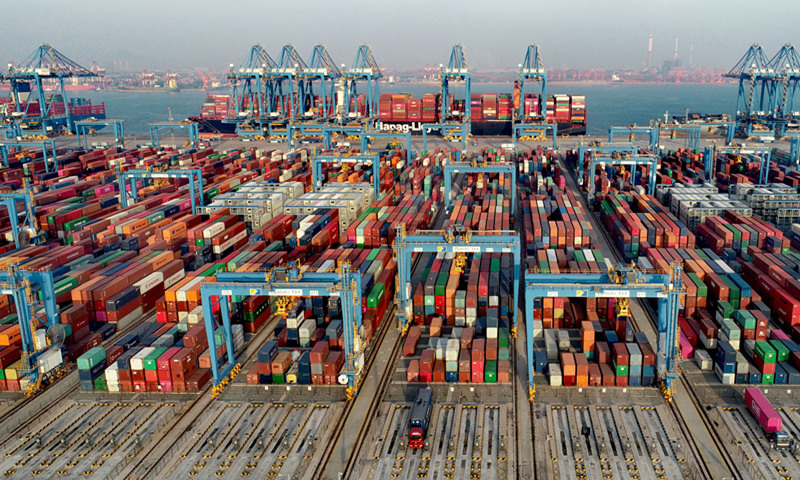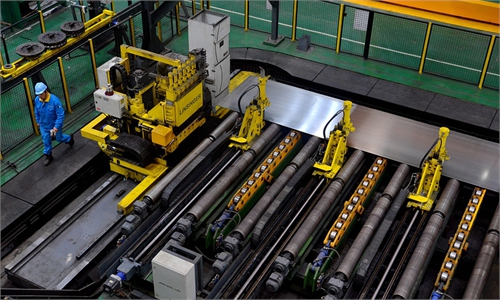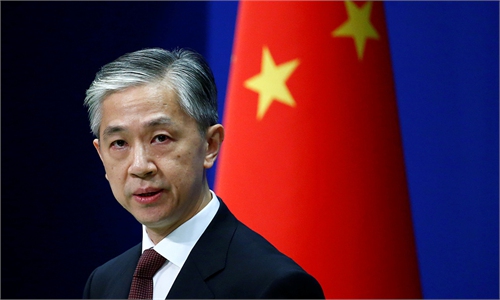31 China’s provinces and regions set GDP growth targets about/above 6%
2021 a ‘big year’ for China’s economy to rebound

A fully automated wharf at the Qingdao Port in the Free Trade Zone (FTZ) in East China's Shandong Province is bustling. The FTZ, open for one year, focuses on the development of modern trade, logistics, finance and advanced manufacturing. Over the past year, more than 5,000 enterprises have been established there, with investment of more than 60 billion yuan ($9.13 billion). Photo: cnsphoto
Despite wide speculation that China has not so far set a national target for GDP growth in 2021, most of China's provinces and regions have set their own targets above 6 percent this year, signaling confidence to achieve further economic rebound from the coronavirus bite in a "big year" for the Chinese economy.
Among the 31 provinces and regions that have announced economic growth targets for 2021, Central China's Hubei Province, which was hit hardest by the coronavirus last year, and South China's Hainan Province where China is building a high-level free trade port, have both banked on goals "above 10 percent," the highest among all provinces and regions in China.
Shanghai, Beijing and China's Guangdong Province set growth targets of "above 6 percent" for 2021, up from a goal of "about 6 percent" for the previous year.
The top three provinces and regions achieving highest economic growth rates in 2020 - Tibet Autonomous Region and Guizhou and Yunnan provinces in Southwest China - vowed to continue growth at 8 to 9 percent this year.
China usually reveals its national GDP growth target at the annual two sessions, the country's main legislative meetings, but some analysts said they do not expect a target to be revealed at this year's two sessions that will convene on March 4 in Beijing.
Wu Chaoming, chief economist at Chasing Securities, said it should be certain that all Chinese provinces can achieve an above 6 percent growth this year based on the low growth base last year and that 2021 will be a "big year" for China's economy.
"The targets have been conservative, and I believe they can be achieved for certain," he said, predicting that China could achieve GDP growth of about 8.5 percent this year.
According to Wu, domestic GDP growth should surge, particularly in the first half of the year, as China's manufacturing can still benefit from rising overseas demand as a result of a pandemic-triggered production standstill in overseas countries.
China's official manufacturing Purchasing Managers Index (PMI) in January stood at 51.3 - the 11th consecutive expansion, indicating vibrancy in China's factories which have been churning goods that are needed by the world.
In addition, the country's "stay put" policy which asked people not to travel during the past weeklong Spring Festival holidays will also boost manufacturing and exports as many continued to work to earn extra bonus, Tian Yun, vice director of the Beijing Economic Operation Association, told the Global Times.
For instance, a stock factory in Yiwu, Zhejiang Province, a city known as the world's capital of small commodities, rewarded each worker who stayed a bonus of 12,000 yuan ($1,850), media reported.
But Tian noted China's export goods may shift this year from the boom due to heavy demand for ventilators and masks in 2020 to COVID-19 vaccines this year, which will become a mainstay of China's exports.
According to official data, Chinese customs exported 438.5 billion yuan worth of medical supplies from March to the end of 2020. Among them, 340 billion yuan or 77.5 percent of the export value was contributed by 224.2 billion masks.
That helped China's exports rise 3.6 percent in dollar terms in 2020, and the country posted 2.3 percent GDP growth amid a distressed global economy.
However, analysts pointed out that the heat of economic rise may cool slightly in the third quarter, as overseas supplies are climbing with help of pandemic control, and the effects of China's policy support are mostly in place and will start to lose steam. Tian expects rebounding consumption could offset that loss.
Such hope is not groundless. Looking forward, the successful control of the coronavirus within China means that the country's services industry could recover further, including transportation and tourism.
Take the film industry as an example. The Chinese box office recorded arguably its best peak season during this Chinese New Year holidays, exceeding 7.8 billion yuan in revenue over seven days.
"The record-breaking box office during the Spring Festival holidays showed us that Chinese people's consumption does have potential. A further consumption rebound may come later this year when the weather gets warmer and workers earn more under the containment of the virus," Tian told the Global Times. However, he warned that consumption recovery still remains a challenge.
Wu agreed. "The consumption sector is sure to recover further, but the recovery speed will slow, because China''s small and medium enterprises, a predominant source for individual income, still have difficulties with their business. Also, rising house prices are a hindrance to consumption recovery."
He suggested that the government should increase financial support on the demand side, such as improving the minimum living standard security system to secure income for the low or medium-income population. He also suggested that China should extend credit support for small enterprises and develop manufacturing industries to sustain employment.
In addition, Tian is worried about a massive policy shift and the soaring yuan exchange rate in the short term. The yuan began strengthening against the US dollar in the last six months to the highest level in more than two years.
Compared with the US, Wu said it is impossible that the US' GDP growth could surpass that of China's this year, but it is likely that their economic recovery speed will be faster later in 2021 compared with China, as the US pandemic situation is starting to show signs of stabilization, and they are in urgent need of restocking.





